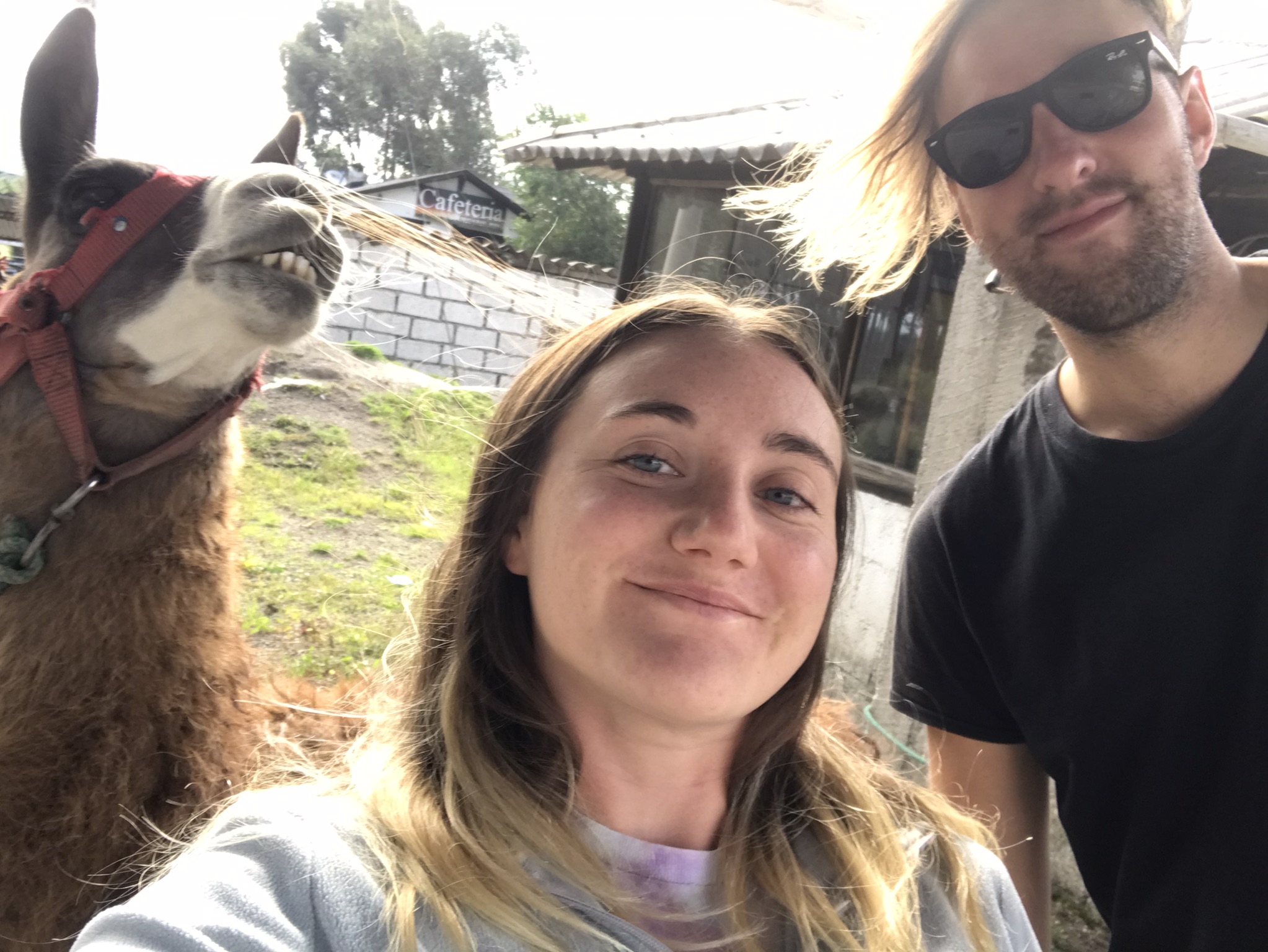Mexico’s capital is the largest and one of the most intriguing cities in the country. Originally founded in the middle of a lake, over the years Mexico City (Ciudad de Mexico or CDMX) has been the capital of three empires and a viceroyalty and today it is one of the largest cities in the world by population. Mexico City is also culturally rich, brimming with world-renowned art, music, food and unique experiences. It is difficult to accurately describe the scale and depth of how much there is to take in in this huge and historic metropolis. With volcanoes, meteorites, ancient ruins, communist history and more, we learned to expect the unexpected here.
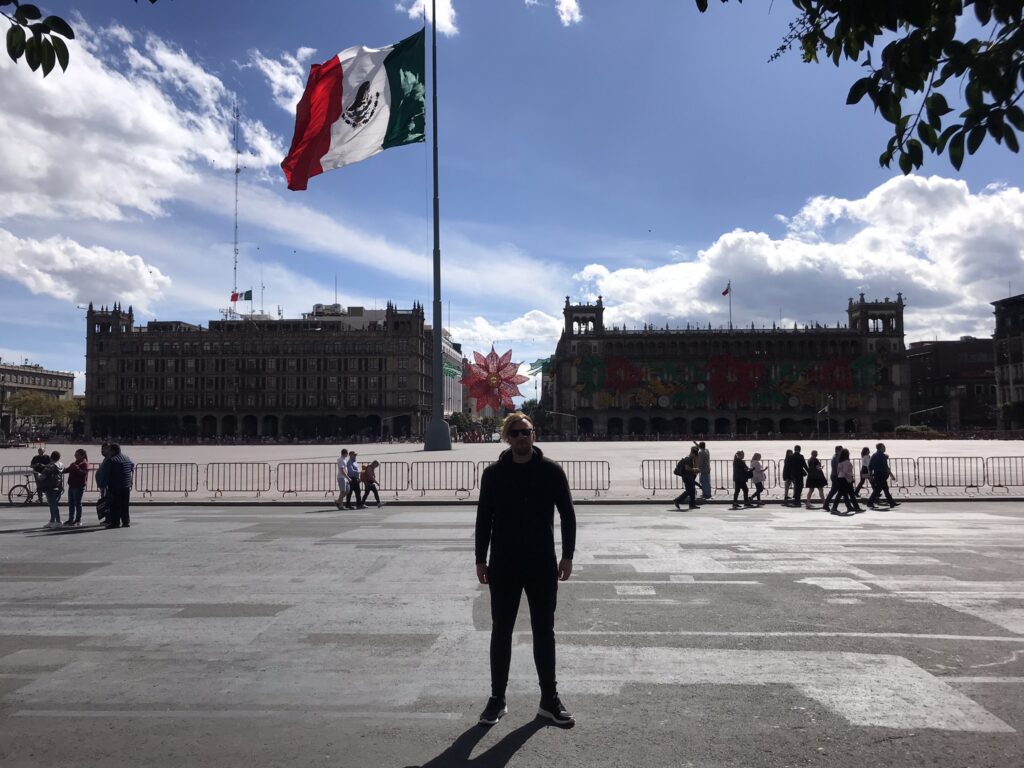
Mexico City was originally known as Tenochtitlan, and was the heart of the Aztec empire. Tenochtitlan was originally built by the Mexica (Aztecs) on a small island in a shallow lake in the Valley of Mexico. The island was artificially enlarged over time using an ingenious method of compacting earth to provide more living space as well as fertile land for agriculture. Eventually the lake was dried out altogether when the city was conquered by the Spanish, creating the basin which is now covered by the sprawling modern city. The centre of Tenochtitlan, the Templo Mayor, sat directly in the centre of the lake island city and today is right next to the Zocalo, the central square of Mexico City.
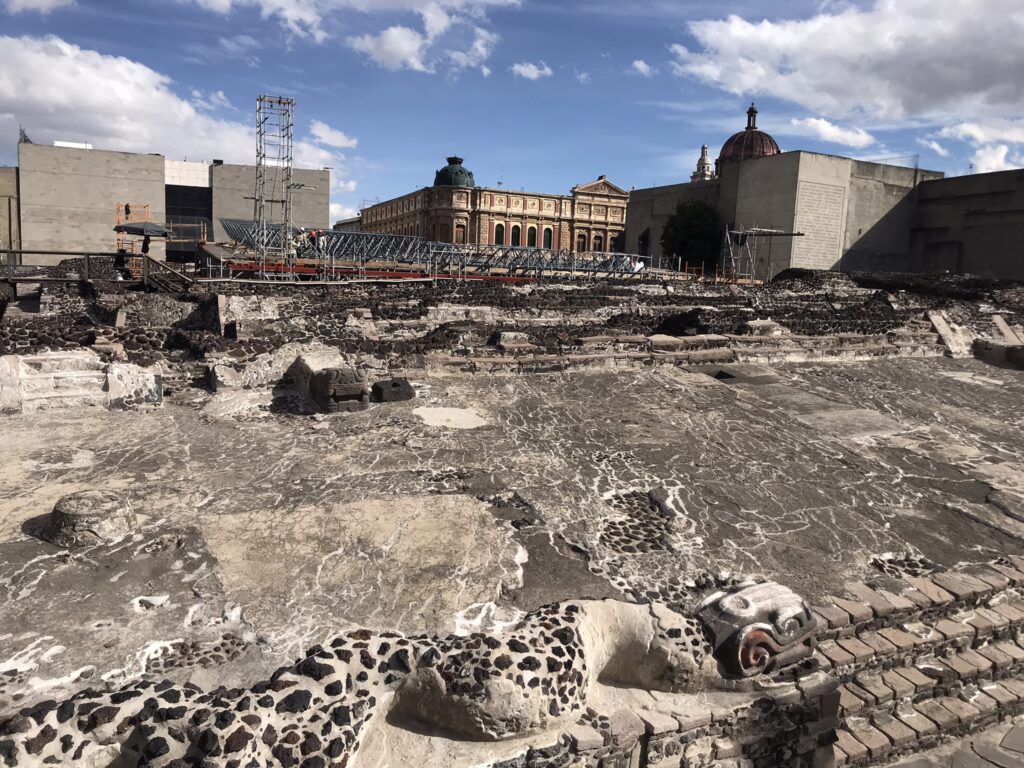
Templo Mayor is exactly in the centre of modern-day Mexico City as well as the ancient Aztec city of Tenochtitlan
Due to being a former lake bed, the land on which Mexico City is built is naturally quite marshy. This means that buildings in the city often need careful monitoring and maintenance to ensure their structural integrity. The most obvious example of this is the grand Metropolitan Cathedral in the Zocalo. An opulent symbol of the Catholic faith and Spanish conquest, it was originally built on top of an earlier Aztec temple which was part of the Templo Mayor complex. Due to its weight, the Cathedral has sunk into the ground over the years. It is now visibly wonky and has to be structurally supported/stabilized to prevent it from collapsing. We were told that at some point the supports will fail and the Cathedral will be destroyed by the pyramidal Aztec temple below, which would then emerge from the earth like something out of an Indiana Jones movie. It is ironic that a symbol of the conquistadors (Catholic church) is being naturally destroyed by an Aztec temple.
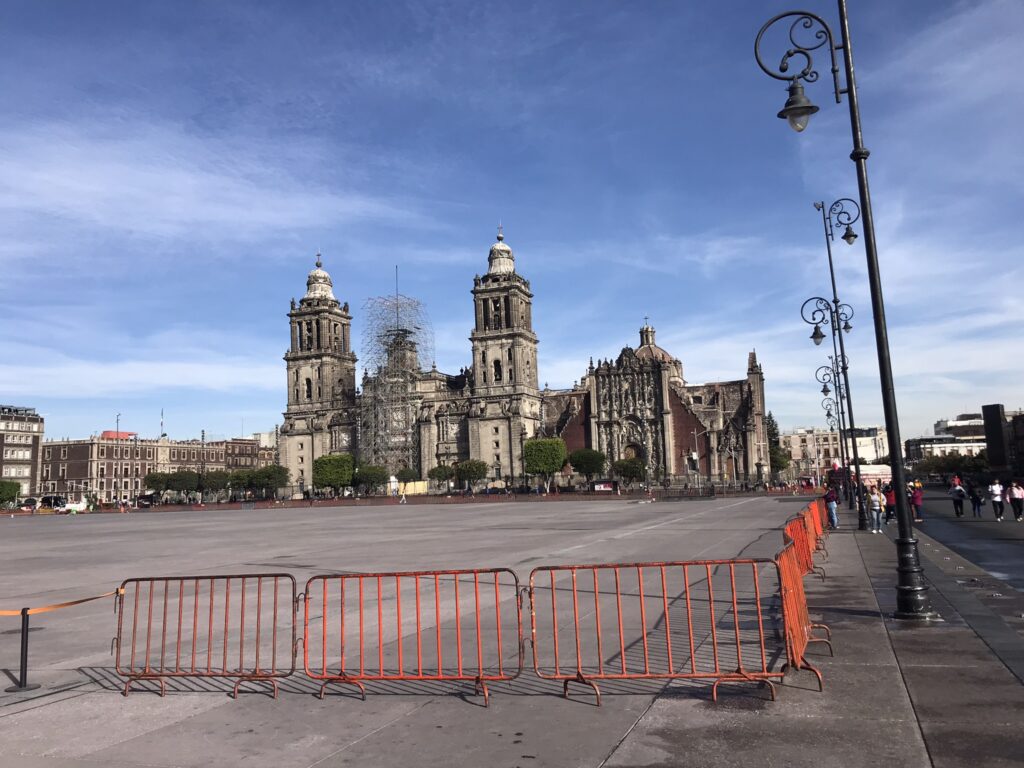
From this angle across the Zocalo it’s possible to see how wonky the cathedral is
The reason for Tenochtitlan being founded in the middle of the lake is explained by the city’s mythological origin story. The legend goes that an eagle clutching a snake in its mouth perched on top of a cactus would be a sign to the wandering Mexica people that they should settle in the area. After supposedly witnessing this on a small island in the middle of the lake, they founded their city there. The symbol of the eagle with the snake atop a cactus is now the Mexican coat of arms, and is seen on the Mexican flag.

The mythical eagle clutching a snake on top of a cactus is both a symbol of modern and ancient Mexico, Chapultepec Castle
As the population grew, the need for land increased and the city expanded over time due to the creation of artificial plots of land. One part of the valley lake, Xochimilco, became a centre of agriculture for the city, using rectangular agricultural plots reclaimed from the lake. Each plot was farmed by an Aztec family, providing the city with a food source. Today it is possible to visit the Xochimilco area and take a boat trip on the canals to see the artificial islands. It is a UNESCO World Heritage Site and is marketed as being similar to Venice. Sadly Xochimilco is now a tourist trap area with unscrupulous boat owners charging a premium for short canal trips and overcrowded waterways full of tourist-laden ‘party boats’.
After conquering the Aztecs, the Spanish rebuilt the city and created dams to regulate the water flow and drain the lake. They then made Mexico City their own capital of the Viceroyalty of New Spain. The Zocalo, with the Temple Mayor, Cathedral and National Palace, has been the centre of the city in ancient, colonial and modern times. We found a wide variety of people hanging around the Zocalo, from prospective tour guides to tarot card readers, uniformed old men with music boxes who were raising money for charity and guys dressed in full Aztec-style attire performing what they claimed was some sort of cleansing ritual, complete with incense and palm leaves. On one evening we saw what seemed to be some sort of informal Aztec-inspired group dance performance in the Zocalo.
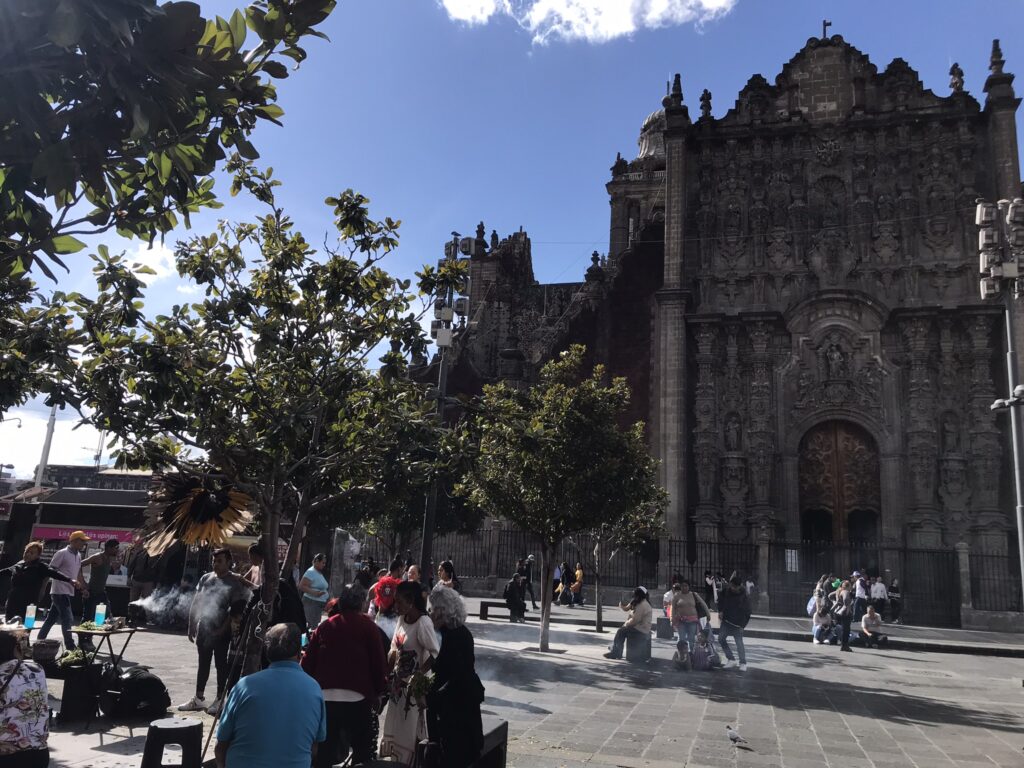
In the shadow of the cathedral you can find shamans conducting spiritual healings
Interestingly we heard that residents of the centre of Mexico City are reluctant to excavate the ground around their homes and businesses in case they find Aztec ruins or artefacts, because they would then have to surrender their land to the government for archaeological research. It’s advantageous for them not to dig in the first place as practically the whole city is built on Aztec ruins.
Despite the city’s size, we found getting around in Mexico City to be very easy due to the extensive metro network. The metro is very cheap, easy to navigate and links many different parts of the city, as well as providing easy access to the major inter-city bus terminals. The metro is busy and crowded at peak hours with people tightly crammed in, but this is expected from mass transit in a major city. Overall we found the metro to be very good and efficient, in fact we didn’t actually use any other form of transport in the city apart from the metro and walking. Interestingly we saw virtually no other foreigners on the metro at all. I’m not sure why this is as we found it to be safe, convenient, cheap and by far the best way to get around.
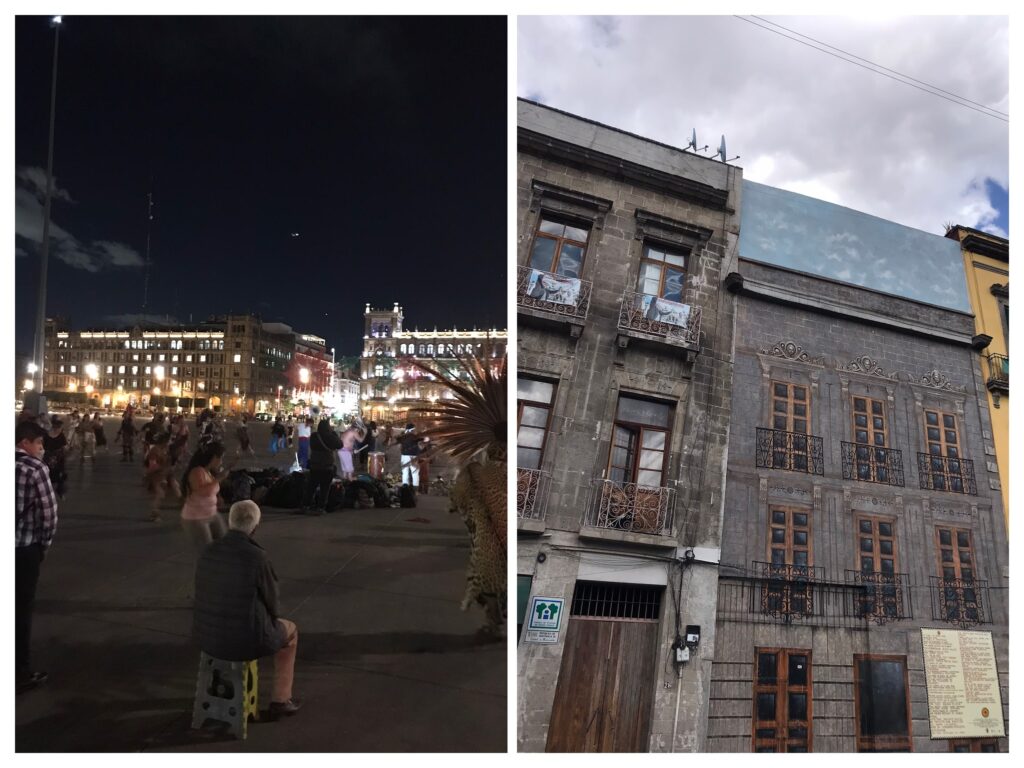
An Aztec dance session in the Zocalo and fake façade of a building that has archaeological remains under it
When we first arrived in Mexico City we tried to buy individual tickets for each metro journey at the station ticket booths to avoid paying slightly extra for a metro card. However we quickly realised that it was not possible to buy individual tickets at many stations, so we were forced to buy the metro cards in the end. We should’ve just got them straight away really, the cards are cheap enough and the journeys were so much quicker and easier without having to buy a ticket each time. If you are staying in Mexico City for any length of time and planning on using the metro regularly, it is definitely worth buying a metro card. You will find at some stations you can’t travel without one.
Foodie Places
There are many higher-end restaurants around the centre of Mexico City, but a few cheaper places too for those on a tight budget (like us!).
La Vasconia SA de CV – no matter what meal time, from 7am-9.30pm this place was open serving Mexican classics like chilaquiles, enchiladas and tortas. There is both a café and a bakery area, both were open all day and we sometimes found ourselves eating multiple times a day here. In terms of the price to quality ratio, we found it to be the best place in the area. Our highlights were the Oaxaca cheese tortas and the chilaquiles.
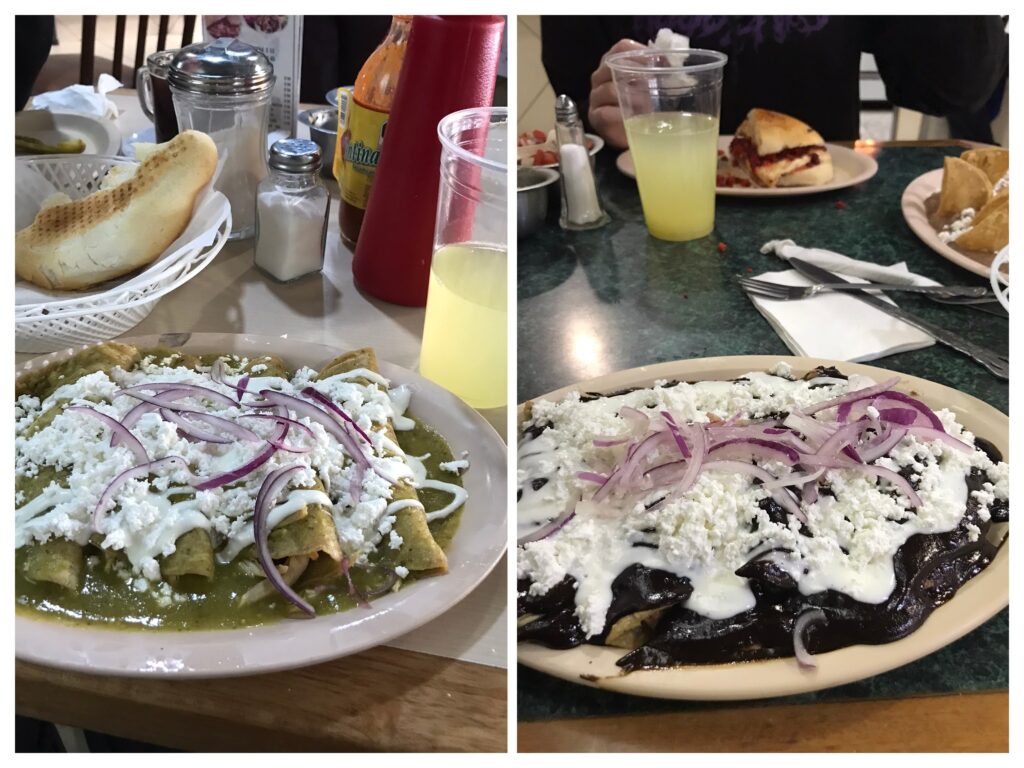
Two Mexican classics: chilaquiles and mole at La Vasconia SA de CV
Taqueria Arandas – a very busy little taqueria with seating upstairs. This is a cheap and typical taco place in the centre of Mexico City. There is a slightly chaotic atmosphere here which adds to the experience. We liked watching the chaos unfold from the balcony seats on the top floor. While it seemed disorganised at first, in reality the system and all the staff worked like clockwork, from the waitresses to the guy grilling the tortillas. It is a quick and efficient place for tasty cheap tacos.
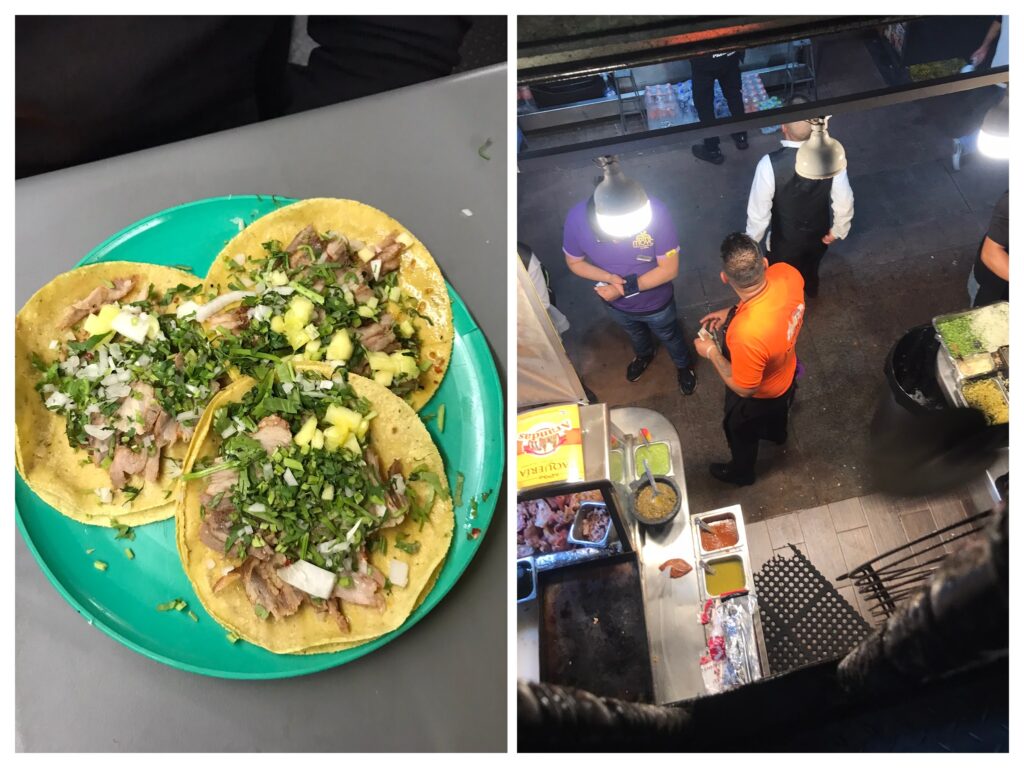
Watching the magic happen at Taqueria Arandas
El Molino – a great place to grab a quick lunch or baked goods for lunch if you’re heading out on a day trip. All the food is to take away but there are a few tables and seats outside if you want to sit down to eat. This was our first experience of a typical Mexican bakery and we were a little confused at first about how to order. We quickly realised that there are trays and tongs available for customers to use. Grab a tray and tongs, put your baked goods on the tray then take them to the till to pay. This is the same throughout Mexico.
Pirates Burger – we saw this fast food chain everywhere around the centre of Mexico City. Dan got a burger and fries here and said it was ok, not much different from a typical McDonalds/Burger King burger and a similar quality and price.
Surprisingly, we struggled to find supermarkets in the city centre. Most of the convenience stores only stock crisps, chocolate and fizzy drinks, with even the bigger stores having only very basic items. This meant that despite our hostel having a kitchen, it was quite difficult to find ingredients to cook for ourselves. You’d probably need to visit a market outside of the historic centre to find the ingredients to prepare anything other than a very basic meal.
Accommodation
Mexico City Hostel – centrally located with a shared kitchen. We were shocked at the low price and large, spacious room considering how close this was to the Zocalo (literally a minute or two down the street). This was really more of a hybrid between a hotel and a hostel. There seemed to be some odd comings and goings, with people delivering random large parcels at strange hours and what appeared to be groups of older Mexican men sitting and loitering around the reception area at times. However our experience was comfortable enough.
Activities
Guruwalk walking tour of the city centre, with stops including Palacio Postal (a grand post office building built in a French style by the former Mexican President Porfirio Diaz which still functions as a post office), the House of Tiles (a colonial building with an Andalusian/North African-influenced moorish tile design) and the Palacio de Mineria, where you can see actual meteorites in the entrance foyer.
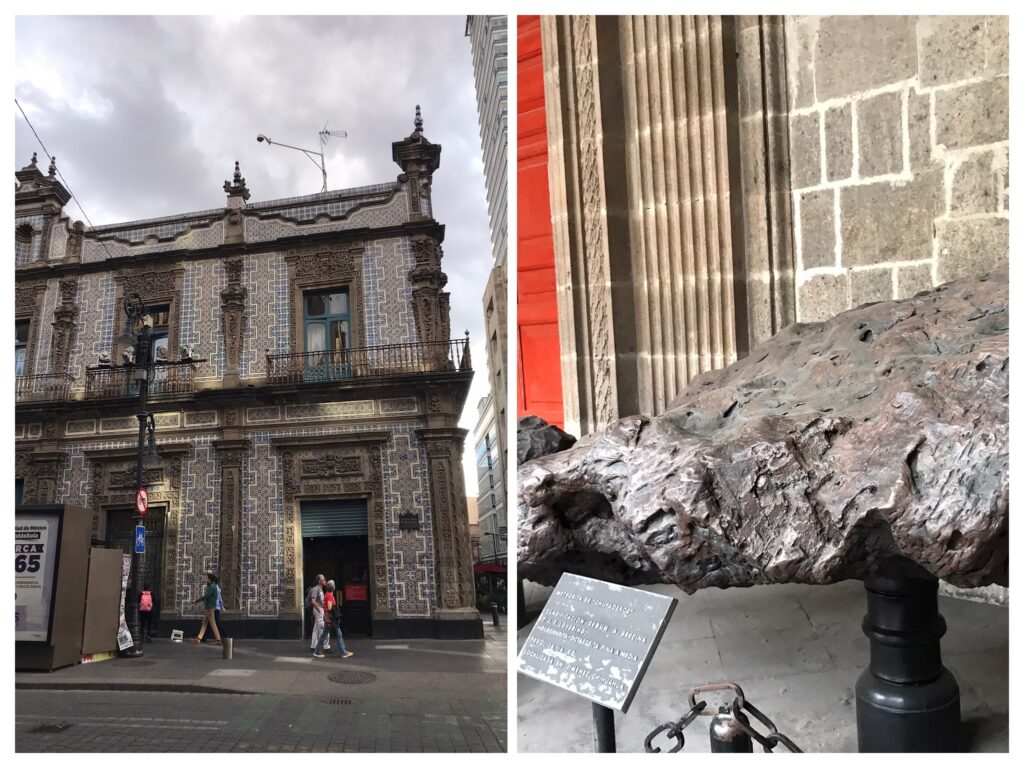
House of Tiles and meteorite in the foyer of Palacio de Mineria
Chapultepec park – a vast swathe of greenery in the middle of the metropolitan centre. The park is peaceful, containing a boating lake where it is possible to rent pedalos. At the south side of the park is Los Pinos, which was the official residence of the President of Mexico from the 1930s until 2018. The grounds of Chapultepec park are free to enter but its main attraction, the Chapultepec Castle, is paid admission.
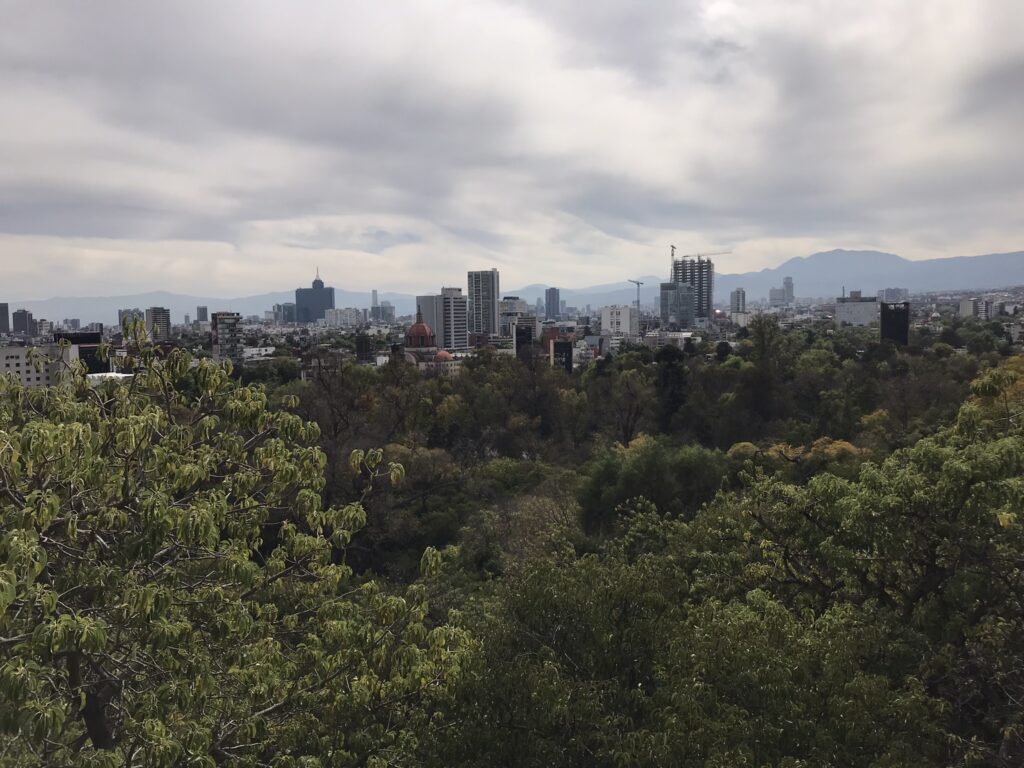
Chapultepec Park sits in the middle of an urban jungle
Chapultepec Castle – the castle is located on a hill at the east side of the park. It was built during colonial times as a residence for the Viceroy and has been at the centre of many important events in Mexican history since then. After the colonial period the castle later became the residence of the Emperor Maximilian during the short-lived Mexican Empire, and later was the official residence of the President of Mexico until the 1930s. Today, the castle contains an informative and thorough museum about Mexican history from the colonial era through to the Habsburg period and the modern day. Some of the rooms have been restored with antique furnishings to resemble the 19th century royal style. As well as being a beautiful building, the museum is very interesting and informative. You can also find great views of Chapultepec Park and the modern city encroaching from the balconies here.

Exploring Chapultepec Castle
Museum of Anthropology – if you only visit one museum in the whole of Mexico it has to be this one. A massive museum with rooms dedicated to ancient civilisations from all parts of Mexico, from major powers such as the Mayans, Aztecs and Teotihuacan through to smaller regional civilisations and powers. The museum contains really in-depth descriptions of each civilisation with regards to religion, funeral practices, customs and beliefs and daily life. There is a mind-boggling amount of artefacts and information. You would really have to arrive early and spend all day at this museum in order to visit all the rooms and take it all in. We spent hours there and still didn’t have enough time to see everything.

Some of the artefacts in the Museum of Anthropology
CMLL wrestling at Arena Mexico – one of the most famous professional wrestling venues in the world, Arena Mexico is a mecca for Lucha Libre. The arena is a little difficult to spot at first from the outside, however the masses of people and hordes of vendors selling lucha masks and merchandise outside the arena should be a giveaway. Inside, Arena Mexico is a large arena with reserved seating and a professional setup including TV cameras. CMLL is one of the oldest and most prestigious wrestling companies in Mexico and runs weekly shows at both Arena Mexico and the Arena Coliseo, which is also in Mexico City. As lucha fans we were excited to attend a show and bought front-row seats, however the lucha libre is a popular night out even for people who are not regular watchers of pro wrestling and you don’t need to be anything like an expert to attend and enjoy the show. We found the experience and setup at the Arena Mexico was similar to a typical wrestling show that you might see on TV, as opposed to the Arena Coliseo which had more of a fight club feel. The action was fast and exciting, the quality of wrestling was good and we had a great time.
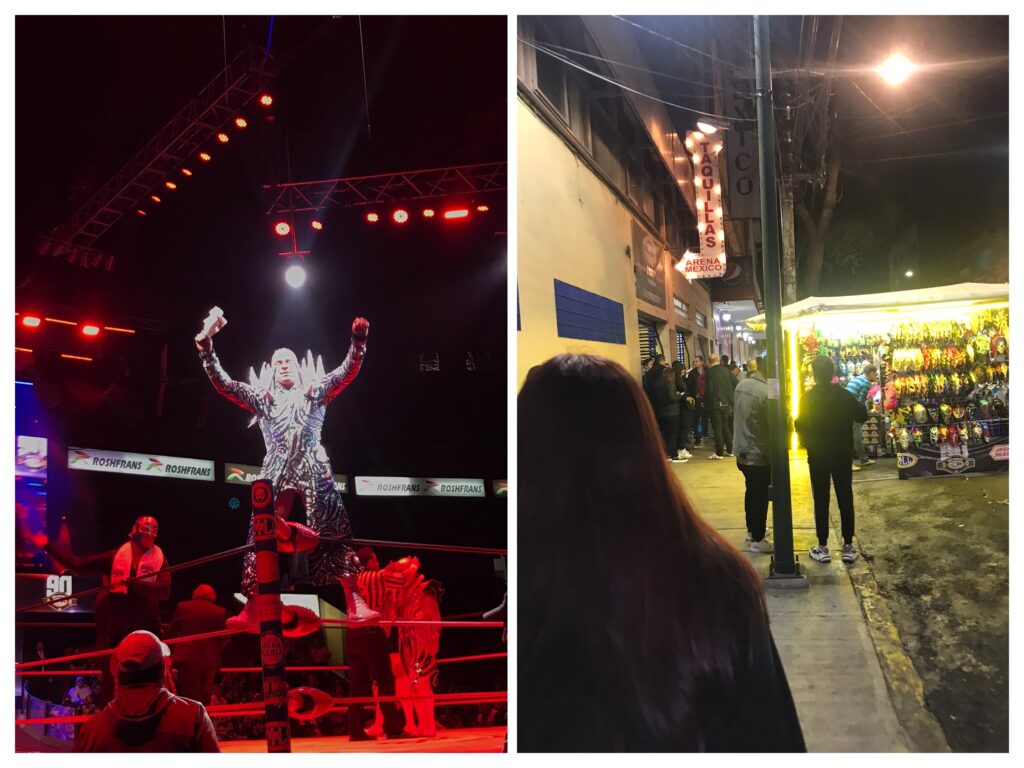
Volador and the slightly innocuous entrance to Arena Mexico
The show was well attended and the local fans were very animated and engaged, constantly shouting insults and encouragement in Spanish. From what we could understand, some of the things that were being shouted were very insulting/crude, drawing laughs from large sections of the crowd. Wrestling stars are adored in Mexico and loved by the audience. The crowd seemed to have their die-hard favourites including Mistico, a former WWE wrestler who was the biggest star on the show and received a hero’s welcome when he emerged for the main event.
We booked ringside seats at Arena Mexico via Ticketmaster. It’s important to note that if you don’t want a wrestler to be thrown onto you or be too close to the action, the second row seats might be better for you. We found that the ringside seats were very affordable. However the food and drink prices in the arena were extortionate so it’s best to eat before you arrive if possible. You can order food and drinks from your seat, good if you don’t want to miss any of the action but quite annoying as the vendors would constantly walk around blocking the view. Beer with michelada (sour salty sugary rim) is a popular (but expensive) beverage at the arena.
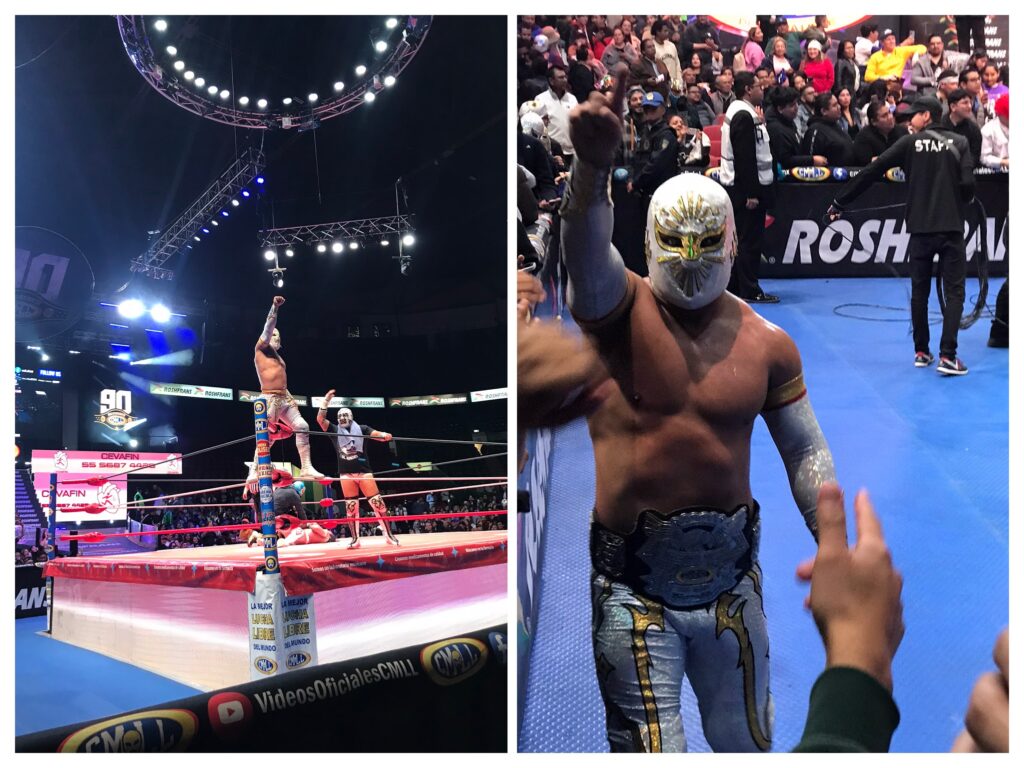
Mistico was a fan-favourite with the crowds at Arena Mexico
You’re bound to spot quite a few gringos in the crowd who’ve bought lucha libre packages/experiences through their hostel or online, usually including tickets and transport. It’s much cheaper to book tickets through Ticketmaster and make your own way to the arena rather than buying one of these packages, but they are still very popular amongst gringos. Some people on these package experiences were still arriving half-way through the show, which seems like a waste.
CMLL wrestling at Arena Coliseo – compared to Arena Mexico, this was a back to basics wrestling experience. The arena is in the city centre within walking distance of the Zocalo. It is a circular cauldron which creates more of a cage-fight/fight club feel and a more intense atmosphere than Arena Mexico. On the circular wall surrounding the lower tier is a very interesting mural with wrestling legends from bygone decades who have performed at the arena. It is a very historic venue. The tickets to the Arena Coliseo were really cheap, much more so than Arena Mexico. There were many more locals than gringos at the show, probably because of the cheaper ticket price. We sat in the unreserved seating in the upper tier. The concrete bleachers weren’t particularly comfortable, you get a numb bum very quickly! The audience in the upper tier is crammed in together and you might find that people have to step over/around you to go to the concessions or the toilet. There are reserved seats on the ground floor with slightly more expensive tickets.
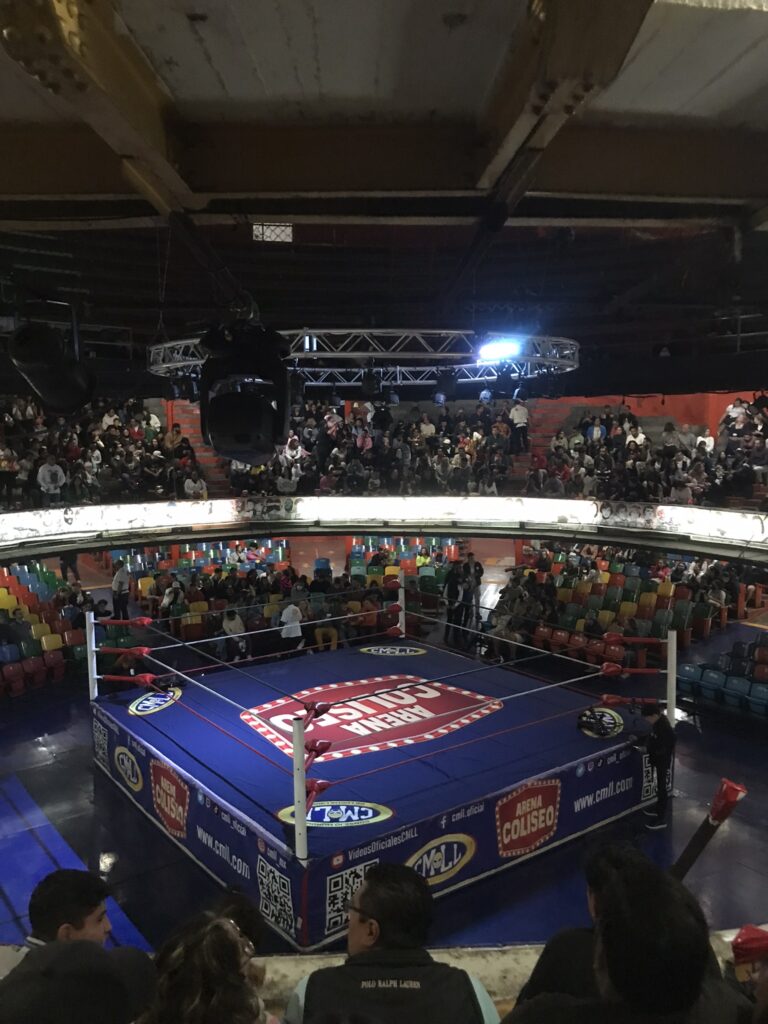
Arena Coliseo is a much grittier venue than Arena Mexico
Templo Mayor – this is an open-air archaeological site and museum right in the centre of the city, next to the Zocalo and National Palace. It is the site of the ceremonial centre of Tenochtitlan and the Aztec Empire. The ruins are partially visible from the outside without entering the museum, but some of the ruins are covered to preserve them. Walkways and viewing platforms are in place for the paying public to look at the complex, but excavations are still being carried out so it is not possible to freely explore the ruins. The ruins themselves are not that impressive compared to other well-preserved sites throughout Mexico but it is possible to get an idea of the scale of the site before it was destroyed, and it is definitely interesting to see these ruins right in the heart of the city. The main highlight here is the museum. There are some small exhibits at the entrance next to the ticket office, we originally thought this was the only museum and were underwhelmed until we realised that the actual museum is located outside, behind the ruins. This museum was much bigger and more detailed than expected, full of finds from the temple complex.
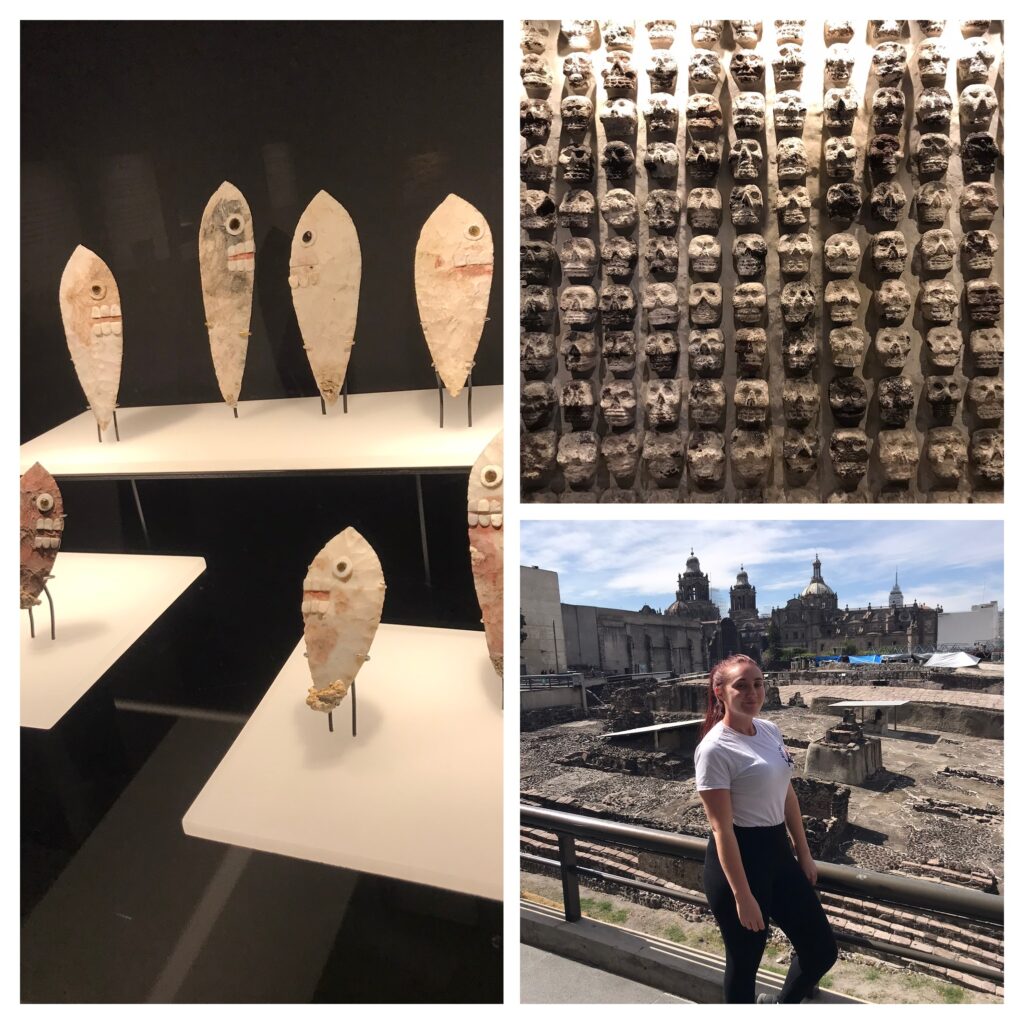
Scenes from the Templo Mayor site and museum
Palace of Fine Arts – this grand building is best known for the fantastic murals on the upper floor. Painted by the likes of Diego Rivera and David Siqueiros in the 1920s-1950s, these are some of the finest examples of the mural art movement in Mexico. There are many overt political pieces portraying the excesses of capitalism and power of the people. Many of the murals depict social injustices and themes of class struggle which were prevalent at time, often featuring the hard-working proletariat as the main focus of the piece.
The most famous mural in the building is Diego Rivera’s Man at the Crossroads. This mural was originally painted on the Rockefeller Center in New York, but it was destroyed when Rivera received a backlash from Rockefeller’s patrons due to the mural’s communist elements, including a depiction of Lenin which Rivera refused to remove. An exact copy of the mural in New York was recreated by Rivera in the Palace of Fine Arts, where it can be seen today still featuring the Lenin figure.
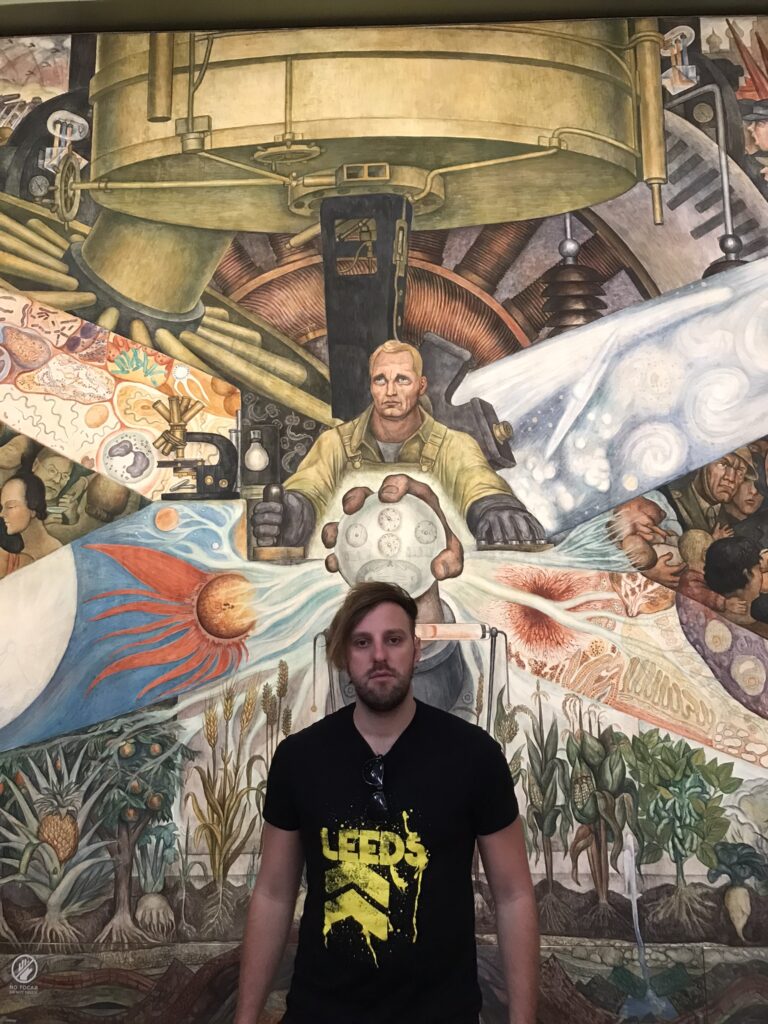
Man at the Crossroads by Diego Rivera in the Palace of Fine Arts
There is a small admission fee to enter the Palace. As well as the murals, there are also some other rooms with exhibitions of art and photography and a theatre which hosts cultural performances. The building is also a work of art in itself, with its grand architecture and intricate marble foyer. The park outside the Palace is a busy and popular meeting place. We even saw rap battles taking place there in the evenings!
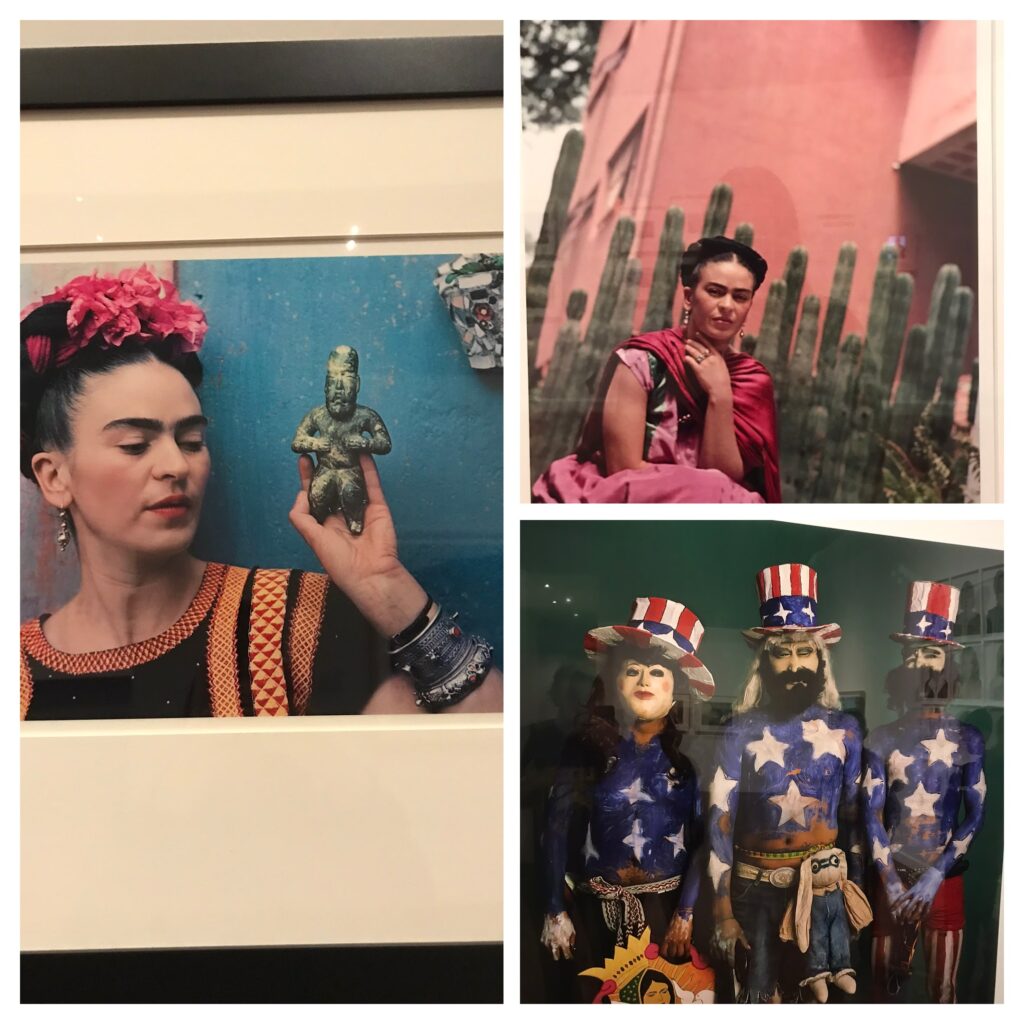
The Palace of Fine Arts also has some photographs of Frida Kahlo and more politically-themed pieces
Frida Kahlo Museum (Casa Azul) – the iconic blue house of the Kahlo family in the Coyoacan neighbourhood. This is the house where the famous artist Frida Kahlo was born, lived her entire life and died. It became a museum shortly after her death. The museum provides a glimpse into the private life of Diego Rivera and Frida Kahlo and the love they shared. To visit you must pre-book a ticket, usually at least a week or two in advance as it’s an incredibly popular tourist attraction and spaces are limited. We personally saw numerous people turn up without a ticket and be turned away while we were waiting for our entry timeslot. We learned that the staff managing the queue often have a hard time with people showing up without tickets and expecting to be let in. You also have to buy a special pass for a small additional cost in order to take photos in the museum – this doesn’t need to be booked in advance, the staff will ask you about it when you arrive and give you a sticker to wear. It’s possible to get to Coyoacan via the metro and walk to the museum, make sure you arrive with plenty of time as entry is strictly controlled and if you miss your entry slot you will not be let in. There’s no leeway for lateness, the house and grounds are very compact so visitor numbers are extremely limited. Even with the tight controls on admission, the house and rooms can get very crowded. You sometimes get swept along in the crowd or find someone blocking the displays/art.
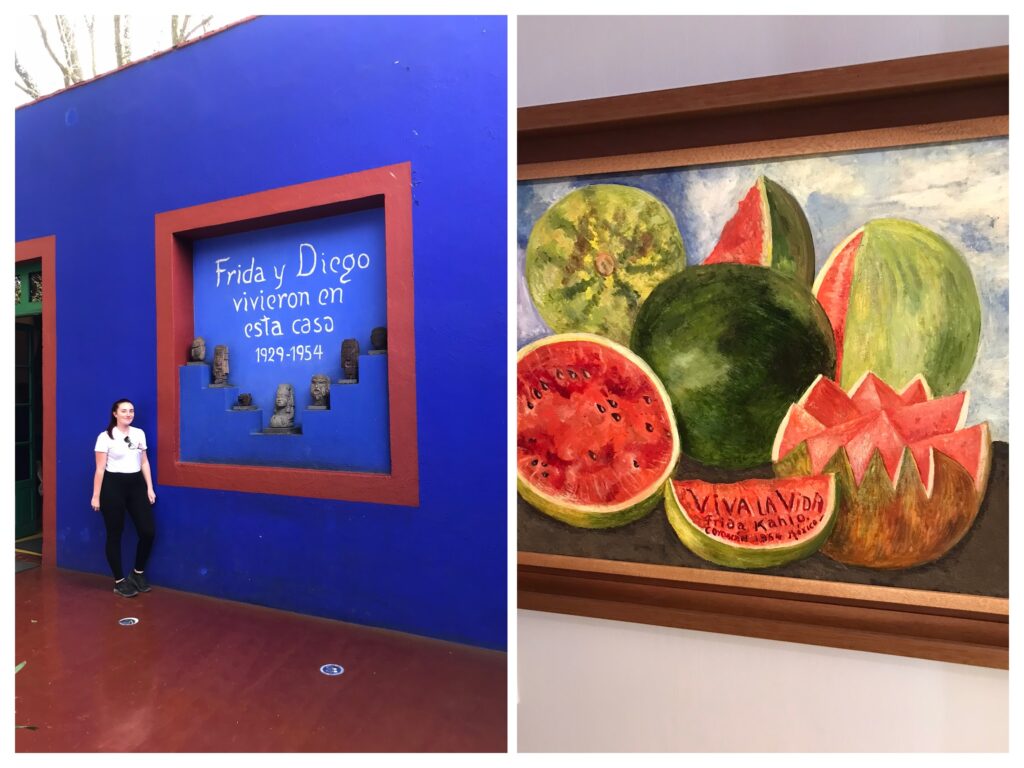
Visiting Frida Kahlo’s Blue House
The museum contains many of Frida Kahlo’s personal belongings (such as her bed, books, art studio and equipment), family photographs, art and iconic clothes. You can see Frida Kahlo’s deathbed, her medical corset, her famous Viva la Vida painting as well as her ashes in an urn shaped like a frog. Sometimes there is not a lot of context to some of the items, however the staff inside the house were very friendly and happy to elaborate or provide additional information that wasn’t written on the info boards. We found that they were knowledgeable and wanted to engage with visitors to enhance the experience. It’s definitely beneficial to talk to the guides to get more information about particular rooms and the life of Frida Kahlo in general, and it is probably also a good idea to do some research about Frida Kahlo before visiting here if you’re not already an expert. The museum is not always self-explanatory.
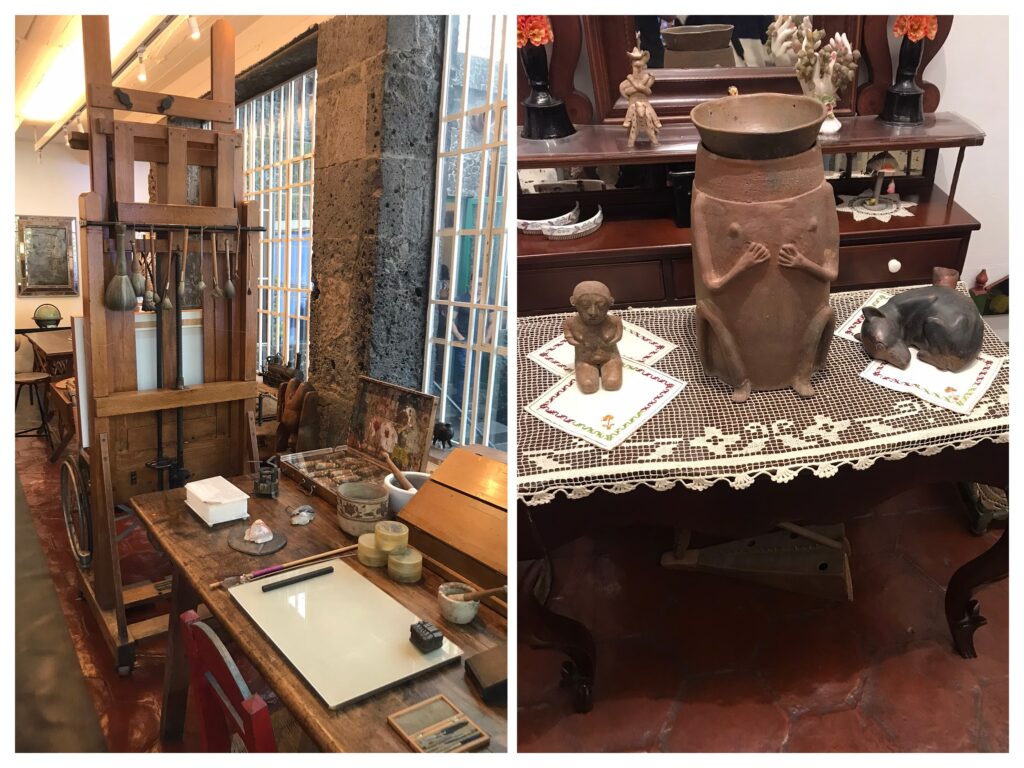
Frida Kahlo’s art studio and ashes in a frog-shaped urn
Coyoacan neighbourhood – after visiting the Casa Azul we took the opportunity to have a look around the neighbourhood using a self-guided walking tour from GPSmyCity. Coyoacan was originally a village in its own right and was used by the Spanish conquistadors as a base in the early years of their invasion when they found that the locals in the village were willing to aid them against the Aztecs. The town was later absorbed into Mexico City during the city’s urban expansion. Stops on the tour included Coyoacan market, Plaza Jardin Hidalgo, Parroquia San Juan Bautista and Fuente de los Coyotes (a Coyote fountain in the heart of the plaza which is a meeting place for friends and families).
Museo Casa de Leon Trotsky – we peeked from the outside as the museum had closed by the time we arrived. Trotsky lived in Coyoacan after being exiled from Russia due to his opposition to Stalin. He initially spent some time living in the Casa Azul with Frida Kahlo and Diego Rivera, and it was rumoured that Frida had an affair with Trotsky. He later moved into his own house in the neighbourhood, where he was eventually assassinated with an ice pick by a Spanish-born Russian agent. This house is the modern-day museum, which is dedicated to political asylum.
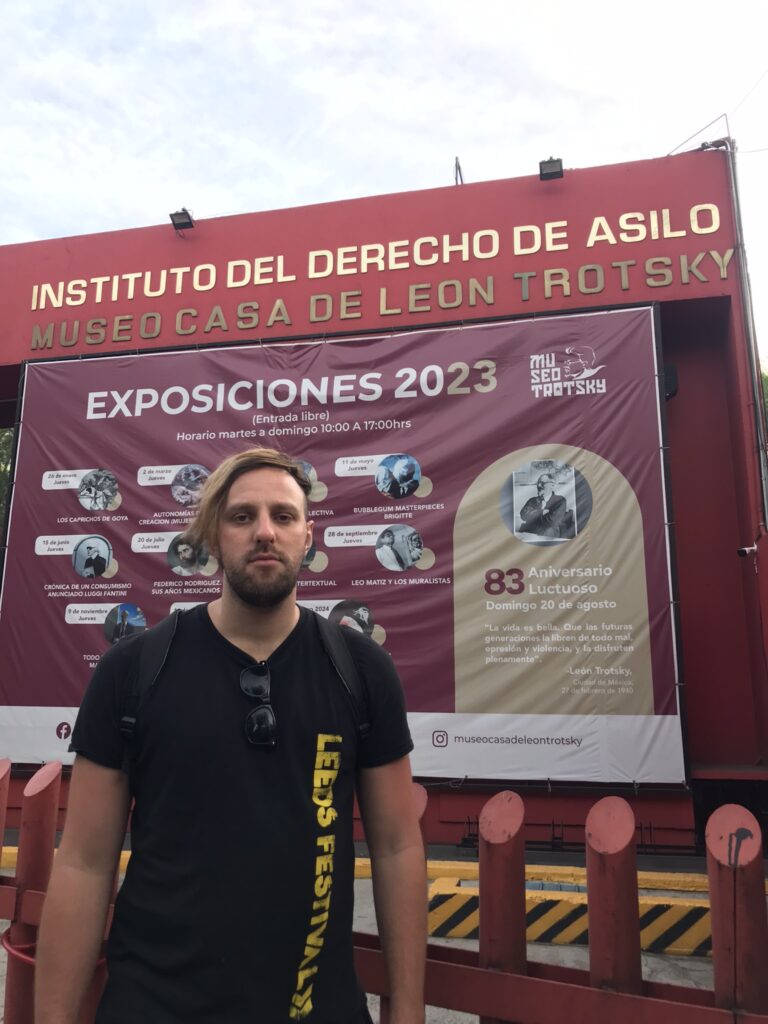
Dan and Trotsky’s red house
Teotihuacan – one of the greatest and most popular archaeological sites in Mexico and all of the Americas. Teotihuacan was the home of a mysterious civilization predating the Aztecs by many centuries. It is speculated that it was one of the largest cities in the world at its peak. The city had already been abandoned by the time the Aztecs arrived, however the Aztecs treated the ruins with reverence, making religious pilgrimages to the site and tying it into their own mythology. Teotihuacan is the name that was given to the site by the Aztecs – the actual name of the city and civilisation is unknown. This is a vast complex with many huge pyramidal temples including the temples of the Moon and the Sun, temples of the Jaguar (red pigment on the façade) and Quetzalcoatl (snake god) as well as the main highway, known as the Avenue of the Dead. There is also a small onsite museum with artefacts that were recovered during excavations. The site takes several hours to explore thoroughly. We arrived just before midday and spent almost 5 hours looking around the site, we only just managed to see everything in this time.
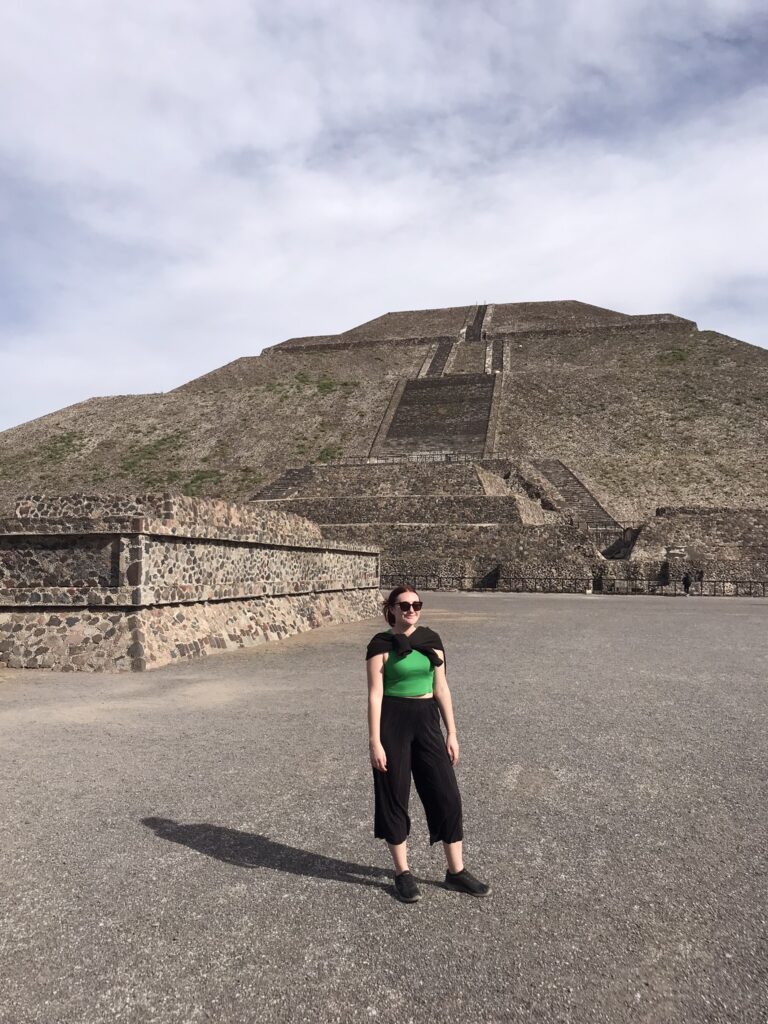
The impressive Pyramid of the Sun, Teotihuacan
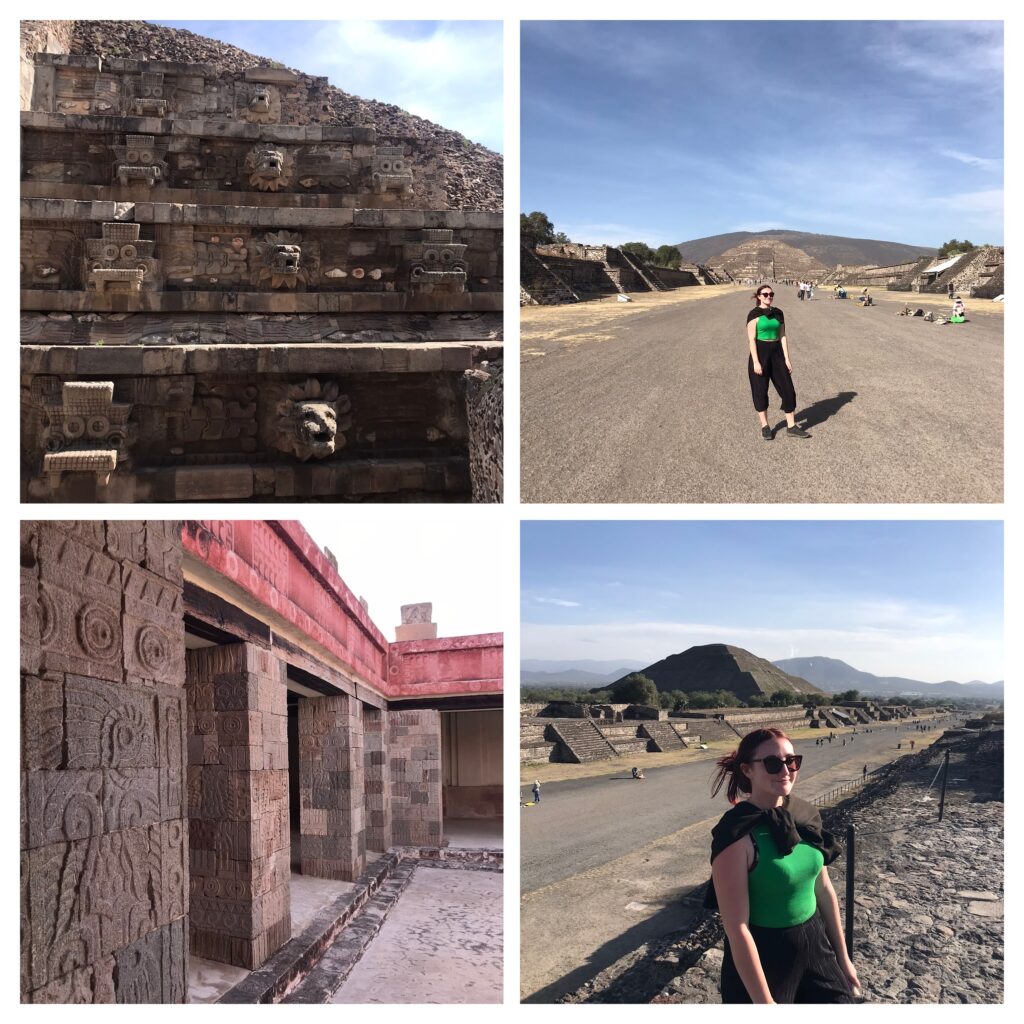
Various scenes from Teotihuacan including Quetzalcoatl Temple, Avenue of the Dead and Jaguar Temple
Teotihuacan is located 25 miles outside Mexico City, near to the small town of San Juan Teotihuacan. San Juan looked like a nice little town in its own right, however we only drove through were able to get a bus directly to the archeological site from the Autobuses del Norte station in Mexico City. At the bus station, head to gate 8 and look for a booth selling tickets to ‘Piramides’. The bus drops off here (19.694026981745772, -98.84945624440192) next to gate 2 of the archaeological site, this is also where you need to wait for the bus back to Mexico City. There is no clearly marked bus stop for the return trip so it can be a little confusing, in the end the bus just picked us up from the side of the main road – wait next to the vendors selling fruit.
There were quite a lot of hasslers when we got off the bus and at the entrance to the site, mostly either selling tourist tat or offering guided tours. If you don’t want a tour then just ignore them. We chose to do a self-guided tour that we found online rather than paying for a guide and we didn’t feel like we missed out on anything by doing this. There were also a handful of vendors inside the archaeological site itself lining the Avenue of the Dead, again selling mostly tourist trinkets. We did find a vendor selling Mexican-style ice lollies (known as patelas), which were very welcome on a hot day.
From Mexico City we also took a day trip to Tepoztlán. Check out the rest of my Mexico content here!
